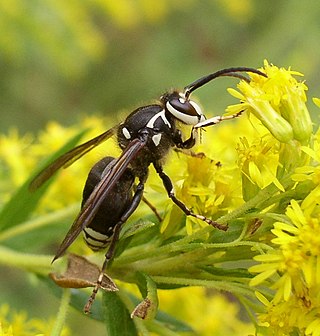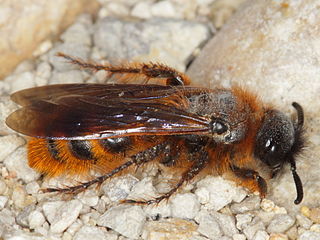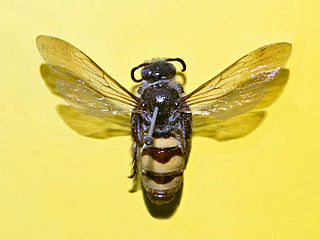
The Scoliidae, the scoliid wasps, are a family of wasps comprising about 560 species worldwide. They tend to be black, often marked with yellow or orange, and their wing tips are distinctively corrugated. Males are more slender and elongated than females, with significantly longer antennae, but the sexual dimorphism is not as apparent as in many of the Tiphiidae and Thynnidae.

Vespoidea is a superfamily of wasps in the order Hymenoptera. Vespoidea includes wasps with a large variety of lifestyles including eusocial, social, and solitary habits, predators, scavengers, parasitoids, and some herbivores.
Flower wasp can refer to:

A wasp is any insect of the narrow-waisted suborder Apocrita of the order Hymenoptera which is neither a bee nor an ant; this excludes the broad-waisted sawflies (Symphyta), which look somewhat like wasps, but are in a separate suborder. The wasps do not constitute a clade, a complete natural group with a single ancestor, as bees and ants are deeply nested within the wasps, having evolved from wasp ancestors. Wasps that are members of the clade Aculeata can sting their prey.

Scolia dubia, also known as the two-spotted scoliid wasp or a blue-winged scoliid wasp, is a species in the family Scoliidae.

Austroscolia soror is a species of scoliid wasp and a common insect found in eastern Australia. This is one of several Australian species collectively referred to as a blue flower wasp, black flower wasp, or blue hairy flower wasp.

Campsomeris is a Neotropical genus of the family Scoliidae, also known as the scoliid wasps. They are generally parasites of beetle larvae, most often of Scarabaeidae.

Dasyscolia ciliata is a species of scoliid wasp found throughout the Mediterranean. It is the only species in the genus Dasycolia. It is the only known pollinator of the European Ophrys speculum. The male wasp is tricked into pollinating the Ophrys orchid by mimicking the female wasp in appearance and scent.

Ophrys speculum, the mirror orchid, is a species of Ophrys distributed throughout the Mediterranean that is pollinated exclusively by a single species of scoliid wasp.

Dielis trifasciata, also known as the three-banded scoliid wasp, is a species in the family Scoliidae.

Scolia nobilitata, also known as the noble scoliid wasp, is a species of scoliid wasp in the family Scoliidae.

Dielis is a New World genus of the family Scoliidae, also known as the scoliid wasps, formerly treated as a subgenus within Campsomeris.

Pygodasis is a New World genus of wasps in the family Scoliidae, formerly treated as a subgenus within Campsomeris.

Campsomerini is a cosmopolitan tribe of the family Scoliidae. An older, alternative representation of this group is as a subfamily, Campsomerinae.

Scolia bicincta, the double-banded scoliid, is a species of scoliid wasp in the family Scoliidae.

Dielis plumipes, the feather-legged scoliid wasp, is a species of scoliid wasp in the family Scoliidae.

Dielis dorsata, the Caribbean scoliid wasp, is a species of scoliid wasp in the family Scoliidae.

Dielis pilipes, the hairy-footed scoliid wasp, is a species of scoliid wasp in the family Scoliidae.

Dielis tolteca, the Toltec scoliid wasp, is a species of hymenopteran in the family Scoliidae. It is commonly found on plants in the genus Solidago.

Dielis tejensis is a species of scoliid wasp. It is endemic to Texas.

















